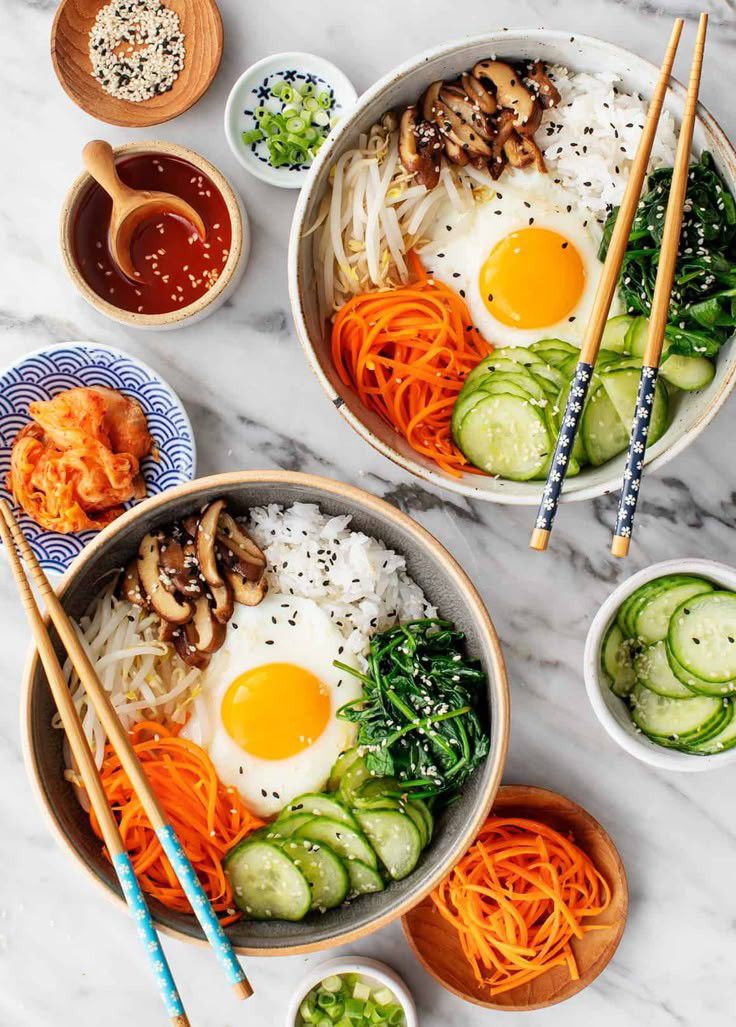ADVERTISEMENT
### Instructions:
#### 1. **Prepare the Beef:**
Start by preparing the seasoned beef. In a small bowl, mix together the soy sauce, sesame oil, minced garlic, sugar, salt, and pepper. If you like a bit of heat, you can add a touch of grated ginger. In a pan over medium heat, cook the beef until browned and crispy, breaking it apart as it cooks. Once done, remove from the heat and set aside.
#### 2. **Prepare the Vegetables:**
Each vegetable is typically prepared and seasoned separately to preserve its individual flavor and texture. Here’s how to do it:
– **Spinach:** Blanch the spinach in boiling water for about 30 seconds, then quickly transfer to ice water to stop the cooking process. Squeeze out the excess water, and then season with a drizzle of sesame oil, salt, and pepper.
– **Bean Sprouts:** Blanch the bean sprouts in boiling water for 2-3 minutes, then drain and rinse with cold water. Season with a little sesame oil, salt, and pepper.
– **Carrots & Zucchini:** Heat a tablespoon of vegetable oil in a skillet over medium heat. Sauté the julienned carrots and zucchini separately for about 2-3 minutes each, until just tender but still crisp. Season with salt and pepper.
– **Mushrooms:** In the same pan, sauté the sliced mushrooms for 2-3 minutes until soft, adding a bit of sesame oil for flavor.
#### 3. **Fry the Eggs:**
In a separate pan, heat a little oil and fry the eggs sunny-side up or according to your preference. The runny yolk will add richness and flavor to the dish when mixed with the other ingredients.
#### 4. **Assemble the Bibimbap:**
In each serving bowl, place a portion of rice at the bottom. Arrange each of the prepared ingredients in separate sections over the rice: the cooked beef, spinach, bean sprouts, carrots, zucchini, and mushrooms.
Top the dish with the fried egg and drizzle a little sesame oil over everything. If you like it spicy, add a spoonful of gochujang (Korean chili paste) to taste. Garnish with a sprinkle of sesame seeds and green onions for extra flavor and texture. For an added kick, a side of **kimchi** makes a perfect accompaniment.
#### 5. **Serve and Enjoy!**
Bibimbap is all about mixing everything together before you eat. The fun of this dish comes from stirring all the ingredients together, allowing the warm rice, sautéed vegetables, and beef to combine with the gochujang and egg. The result is a savory, spicy, and umami-packed meal that’s as satisfying to eat as it is to look at.
### Variations and Tips:
– **Vegetarian Version:** You can easily make bibimbap vegetarian by skipping the beef and adding more vegetables like mushrooms, sweet potatoes, or even tofu for protein.
– **Vegan Version:** For a fully vegan bibimbap, use tofu or tempeh in place of beef, and substitute the egg with avocado or skip it altogether. Be sure to use a vegan gochujang paste (some may contain fish sauce).
– **Gochujang:** Adjust the amount of gochujang based on your spice tolerance. You can always add more or less, depending on how spicy you want your bibimbap to be.
– **Rice:** Short-grain rice works best for bibimbap because it’s sticky and helps hold the ingredients together. However, you can substitute with brown rice for a healthier, whole-grain option.
### The Cultural Significance of Bibimbap:
Bibimbap has deep roots in Korean history. Originally a dish made with leftover vegetables and rice, it was a way to use up food scraps. Over time, it evolved into a more elaborate dish, enjoyed as a special meal. Bibimbap is often served during holidays and festive occasions in Korea, symbolizing harmony and balance. The word “bibim” means “mixed,” and “bap” means “rice,” representing the dish’s central idea—combining diverse ingredients into one cohesive meal.
### Conclusion:
Bibimbap is a beautiful blend of flavors and textures that is both nutritious and filling. Whether you enjoy it for lunch, dinner, or as a meal prep option, it’s a customizable dish that can be tailored to suit your preferences. The combination of seasoned beef, vegetables, a fried egg, and spicy gochujang makes for a deliciously satisfying bowl that will transport your taste buds straight to Korea. So why not try making bibimbap today? It’s an easy, healthy, and incredibly flavorful way to enjoy the best of Korean cuisine.
